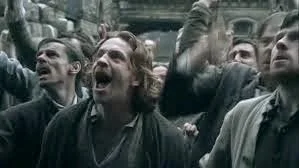The strike for better wages by the cotton workers plays a vital role in Gaskell’s story. Without the strike, there would have been no riot, and no tumultuous interaction between Thornton and Margaret that would lead him to declare his love for her the next day!
Here are some of the details related to the strike, according to the book:
What caused the strike? The workers’ wages were stagnant for two years and the masters announced that they needed to lower the wages.
Boucher and Stephens at the riot in Thornton’s mill yard. (from the BBC’s North & South)
Why did the masters intend to pay them less?
Thornton explains to his mother:
…the Americans are getting their yarns so into the general market, that our only chance is producing them at a lower rate. If we can’t, we may shut up shop at once, and hands and masters go alike on tramp.
The workers didn’t turn out all at once like in the film version. Hamper’s and Slickson’s men turned out first. Thornton’s workers put in another week because Thornton threatened to prosecute them for breach of contract.
What did the Union demand? The workers demanded a 5% increase in pay.
How many strikes have happened in Milton in recent years before this strike? Bessy tells Margaret that she has seen two other strikes fail. And it was during the first strike that her mother died.
What was Higgins role in the Union?
According to Bessy, the Union appointed Nicholas to be on a committee for organizing the strike because he was “reckoned a deep chap, and true to th’ back-bone.”
What was the Union plan?
They had learned from past experience that it was crucial that there should be no going against the law of the land — no violence. If knobsticks (replacement workers) were brought in, they would try to sway them to the workers’ cause.
The Committee charged all members o’ th’ Union to lie down and die, if need were, without striking a blow; and then they were sure o’ carrying th’ public with them.
Why was Boucher’s situation so desperate? Boucher and his wife had 8 children! And all of them were too young to be legally working at the mill.
England passed a law in 1833 that fixed 9 years-old as the minimum age for a factory worker. And in 1844, the law stated that children under 12 could only work in factories for a maximum of six and half hours a day. (Thornton says his hands work 10 hours a day.)
How long does the strike last?
Although Higgins hoped it would only be a week before the masters gave in, the strike lasted at least two weeks. Thornton swore he would wait two weeks before employing Irish replacements.
How many workers did Thornton employ?
Higgins tells Margaret that 700 workers will return to work right away, if Thornton will agree to the 5% raise. 700! That’s a lot of human beings affected by Thornton’s decisions.
A few more interesting details:
Higgins knew that Thornton had orders waiting to be filled when the strike broke out. And that these orders were under contract to be completed before a certain time or there would be a fine to pay.
Higgins was so angry that the riot broke the Union’s non-violence plan that he threatened to turn Boucher in to the police, and Boucher punched him in the face! But Higgins never really intended to turn Boucher in, he was just extremely frustrated.
The doors to the factories opened three days after the riot. And at Hamper’s mill (where Higgins had worked), mill hands returning to work were forced to pledge that they wouldn’t contribute to the Union.
Did you learn at least one thing you didn’t realize before? The war between workers and masters creates great tension in the novel, and is a main reason North and South feels so modern and relevant today.

